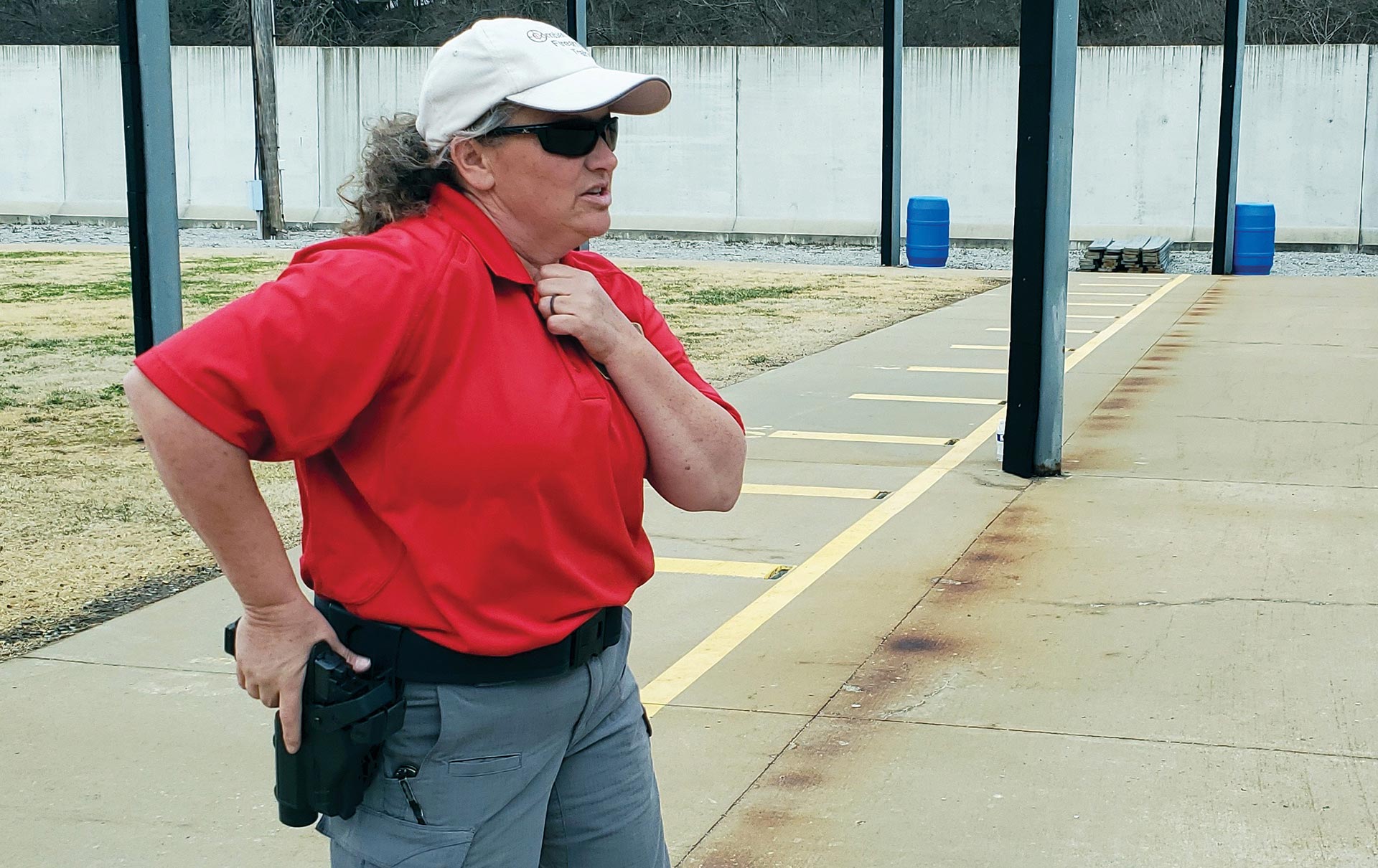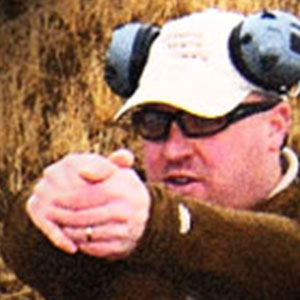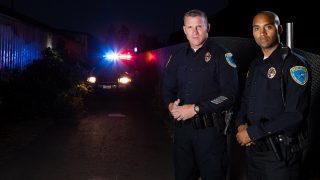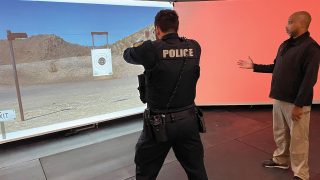
Whether it’s during qualification or in the middle of a fight for your life, if you want more time to shoot well, improving the efficiency of your pistol-handling skills will provide it. An efficient draw, quick and smooth reloads, and target transitions focused on economy of motion can do much more than improve your weapon-handling ability. These skills could save your life.
The draw
Too many officers draw their handgun as if a threat will give them all the time and space in the world. Generally, this is because most officers shoot qualification courses and drills that give them unrealistically long par times. Since they are allowed to be lazy out of the holster, they continue to train at that slow speed. The reason for getting the handgun out of the holster is to confront a threat. The faster and more efficiently the handgun is drawn from the holster, the more time you have to shoot accurately if needed.
The draw starts with releasing the retention devices of the holster and obtaining a high grip on the backstrap of the handgun with your strong-side hand while your support-side hand moves to the upper centerline of your body. Once you remove the handgun from the holster, whatever grip you have is what you have in the fight. It won’t get any better. So, when your strong hand obtains a grip high on the backstrap of the handgun, take a split second to make sure you have established a good grip.
Once you have established your master grip, the middle finger of your strong-side hand should be putting forward pressure on the bottom of the trigger guard as the handgun is lifted up and out of the holster. This is a tip and trick we have been teaching for over 10 years because it results in a more consistent and faster draw stroke. When you put pressure on the trigger guard with the middle finger of your strong-side hand, the handgun will self-level once it clears the holster. You no longer need to lift and level, because the handgun will automatically level. Think how much faster you can get the handgun oriented toward the threat if it comes out of the holster already leveled and pointed at the threat.
As the handgun self-levels, continue moving it in one continuous motion as if you’re drawing up and over a tall table. Your hands come together at the top of the tall table and press the handgun straight out into the eye–target line. If your support-side hand is high on your chest waiting for the handgun, you won’t have any problem bringing your hands together and building your two-handed grip.
Start slowing the handgun down once you get two hands on the gun. When trying to be quick, shooters tend to “spear” the gun toward their target, causing the handgun to bounce like it’s on a spring. Instead, start slowing the handgun down so that it stops smoothly just short of being at full arm extension. This will shorten the time it takes to settle the sights and press the trigger once the handgun is at the shooter’s extension.
To holster, simply bring the handgun straight back into the chest and place your support hand against the upper part of your chest as you direct the muzzle straight down toward your holster. Once the muzzle is aligned straight into the holster, place the muzzle of your handgun into your holster, ensuring there are no obstructions like a shirt, jacket or other foreign debris. Insert the handgun into the holster and secure all retention devices.

Target transitions
Transitioning between targets is another area where we see a lot of officers wasting valuable time instead of being actively involved in the fight. During target transitions, we frequently see officers lowering their pistol after engaging a target; then they transition their eyes to the next target before bringing the pistol back up to their eye–target line. This is very slow and does nothing to solve the problem the targets represent.
Another error we see officers make while transitioning from one target to another is the use of the eyes-on/gun-on method. In other words, they keep their visual focus on their sights, or through the sight when using a pistol-mounted optic, and maintain this focus while moving the pistol to the next target. The result is that the shooter intentionally narrows their field of vision and is basically looking through a straw. This makes shooting slow, but the worst problem is that it makes threat assessment much slower and less accurate. Lastly, when they transition to the next target, they nearly always move the handgun too far, then overcorrect back in the other direction before finally settling on the intended target.
Instead, when working on target transitions, keep the handgun up near the eye–target line and in your normal shooting position. When you’re finished engaging the first target, during recoil of the last shot, transition your eyes to the next target, then your head, then the handgun. Eyes, head, gun. Drive the handgun from one target to the next using your lower body instead of simply pivoting at the waist. Start slowly at first to get used to the “eyes, head, gun” method, then increase the pace.
Reloads
Improving reloads is another area where we can eliminate unnecessary movement. The most common mistake is bringing the handgun in low and too close to the torso, resulting in significant movement of the handgun and eyes off target. Not only does this add precious time to reacquire the target, but taking eyes off a potential threat can also be dangerous.
The other extreme is bringing the handgun in close to the face. This is great when the movie camera is trying to get an actor’s face and handgun into a close-up, but it is not an efficient means of reloading. Instead, find a comfortable working space approximately 6 inches from full extension, straight back toward the shooter. This reduces the movement of the handgun while allowing the reload to occur in an area where the shooter has more control and dexterity. It also keeps the head and eyes up and engaged in the fight. Find the sweet spot. Some shooters will be more comfortable bringing it in a bit closer, and some will move it even less. Either way, minimizing movement will result in faster reloads.
Another way to speed up reloads is to evaluate the angle of the handgun during a reload. The angle of the magazine well affects how quickly a magazine is inserted. By canting the weapon slightly, the magazine well can be pointed at the magazine pouches. This creates a straight line between the fresh magazine and the magazine well. Basic geometry states the shortest distance between two points is a straight line. This straight line is not only fast, but it is also the easiest and surest way to get a magazine seated quickly and securely. You can learn more about improving your reloads at youtu.be/JXsjCV4SYhg.

Practice
The best way to improve your handgun skills is to commit to a regular dry-fire practice routine. Once you get your draw smooth and efficient, move on to target transitions. A few 2”x2” sticky notes on the wall make a great target at 5 yards or so. Draw from the holster and make two trigger presses at each sticky note before transitioning to the next. Work it right to left, then left to right. Mix it up a little by adding reloads into the mix.
Live-fire training is where you test the progress you make during dry-fire practice. One of my favorite live-fire drills to measure performance over time is Ken Hackathorn’s BFM Drill (youtu.be/oRphIXCV8Hs). This drill combines all the skills discussed here and can be further enhanced by adding movement, shooting from cover or making it a rifle-to-handgun transition drill.
When you are serious about getting faster and more accurate, your smartphone may be your biggest asset. Video a few drills for analysis. When reviewing your performance, watch the handgun, eyes and support hand to help identify unwanted and unnecessary movement. You will be amazed by how much extra movement occurs without conscious awareness. Once you’ve improved your efficiency, you will have more time to shoot well.
As seen in the October 2023 issue of American Police Beat magazine.
Don’t miss out on another issue today! Click below:






